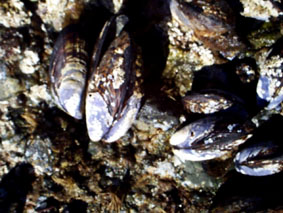
Classification of Southern California Bivalves
Members of the Phylum Mollusca contain a variety of common characteristics. Some common characteristics include a soft body surrounded by some sort of an outer shell secreted by the mantle. The shell may be external or internal or secondarily lost. A strong muscular foot used for locomotion is another common characteristic of the Phylum Mollusca. The molluscs are extremely large in species numbers, approximately 300-400 species of molluscs occur in the intertidal zone of Southern California.The bivalves are in the class known as the Bivalvia, or Pelecypoda, meaning hatchet footed animals. Most are marine, but some live in brackish water. The bivalves show a variety of form and specialization. The taxonomy of bivalves is based on the characteristics of the shell, shape of the foot, the arrangement of adductor muscles and the nature of the ctenidia and siphons. The bivalves are bilaterally symmetrical mollusks, enclosing the soft internal body. Common feeding characteristics of bivalves include filtering out particle food through an enlarged pair of gills known as ctenidia. Most bivalves are sedentary, but some use their foot to glide across substrate. Reproduction in most bivalves is external and most bivalves are separate sexes. The Order Mytiloida, meaning poor teeth, contains the Mytilus californianus,galloprovincialis, with common smooth shells with a few ribs and small denticles near the beaks and Septifer bifurcatus, which contains a shelly septum in the anterior end. The Order Veneroida, meaning perfected teeth, contains the Family Chamidae and the Pseudochama exogyra,which has attachment by a right valve.
The Mytilus californianus, Mytilus galloprovincialis and the Septifer bifurcatus belong to the family Mytilidae whose members are characterized by unequal adductor muscles and scars, a smaller anterior muscle, brown or black shell which is usually cylindrical or tapered in shape. Members of the Genus Mytilus can be separated from other genera within the family by a smooth shell with a few radial ribs and some small denticles near the beak. The Genus Septifer can be separated from other genera within the family by the presence of a shelly septum at the anterior end.
The Family Chamidae contains the Pseudochama exogyra, whose members are characterized by one large muscle scar near the center of the shell and the adductor muscles are at opposite ends of the shell. The Genus Pseudochama can be separated by other genera by attachment of the adductor muscle to the right valve.
Mytilus californianus (Linnaeus,1758)-Mytilus. Common name- California mussel. The California mussel has a rounded hind end, moderately thick-shelled and a purplish grey outer shell. The interior portions are often grey to white. The shell contains strong radial ribs and irregular growth lines. The California mussel is approximately 130mm long. The California mussel dominates mussel beds in most of California. The California mussel is found firmly attached to rocks along the upper middle intertidal zone and offshore to 24m in depth. The California mussel may also be found attached to pier piles. They often aggregate to protect themselves from wave and tidal action. The range of this species is from Alaska to Baja California

Mytilus galloprovincialis (Linnaeus, 1758). Common name-Bay mussel. The Bay mussel, formerly know as the Mytilus edulis, is often much smoother then the California mussel and smaller. The Bay mussel is usually 100mm in length. The shell of the Bay mussel lacks radiating ridges contains three small teeth below the beak. The exterior is often bluish black with the interior portion being dull blue. The Bay mussel is adapted to a wider variety of habitats then the California mussel. The Bay mussel prefers quieter water and lives lower in the intertidal zone attached to rock substrates. The Bay mussel shows considerably more mobility then the California mussel, with the smaller individuals moving to the outer edge of the colony. The range of this species is from the Arctic Ocean to Baja California and on the West coast of South America, Japan, Australia and the North Atlantic.
Septifer bifurcatus (Recluz, 1848). Common name-Bifurcate mussel. The Bifurcate mussel is fan shaped, with a thin shell and contains fine radiating ribs. The hind end is broadly rounded and has a black exterior with a purple interior. The shell is usually only 45mm in length. The Bifurcate mussel is found lower in the intertidal zone in Northern California then Southern California and is often nestled in nooks and crevices.The range of this species is from Crescent City, Ca. to S. Baja California.
Pseudochama exogyra ( Odhner, 1917). Common name- Reversed Chama. The Reversed chama is approximately 50mm in diameter and is cemented to stones by the right valve. The shell is usually badly eroded and dull white with orange siphons and white tenticles. The Reversed chama is found in large clusters on rocks along the open coast. The range of this species is from Oregon to Baja California.
1. Rounded hind end, fanned shaped; exterior is dark purple to gray; interior is light gray; shell is smooth with some light ribs; small denticles near beaks; found on rocks intertidally up to 46m deep......Mytilus californianus
2. Smooth shell, small denticles near beaks; found on rocks in intertidal zone..........Mytilus galloprovincialis
3. Rounded hind end, fan shaped; exterior is light yellow; the anterior end is bridged by a shelly septum; interior is silvery white; found attached to rocks at low tide line.....................Septifer bifurcatus
4. Rough shell; irregular oval shape; attachment by right valve; found attached to rocks, intertidal zone..........................Pseudochama exogyra